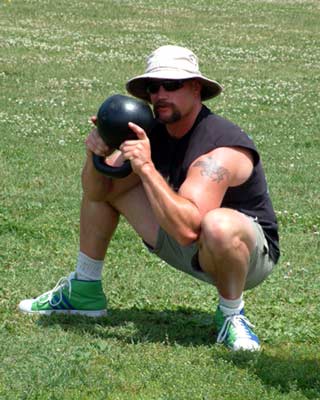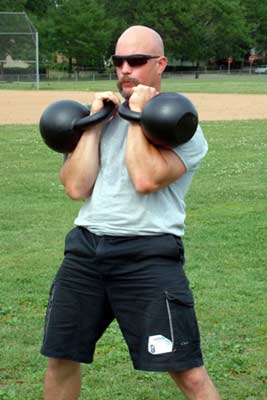So, You Want To Try The Secret Service Snatch Test, eh?
Jared Savik, RKC
For those who have done it and are contemplating doing it again, it can evoke feelings of dread. For those who have not tried it, it is a curiosity, and perhaps a perceived measure of their kettlebell (kb) manliness. What is it? It is the Secret Service Snatch Test and it is not for the faint-of-heart.
With its origins in the prestigious U.S. Secret Service selection process, the rules are simple. You must do as many repetitions of the kettlebell snatch as possible in ten minutes. Using the 24kg kettlebell (ladies, use the 12kg), you may switch hands whenever you’d like and you may even set the bell down (so you can toss your cookies). Final count is total sum of snatches, period. The only unspoken rule is that you will not quit. Got a blister, tough, use the other hand for the remaining time. Tear a callous, tough it out. Don’t even think about stopping when the phone rings. You can rest the kb on the deck to keep a lung down, but it’d better be moving when the timer sounds.
“What is a good score?” everyone wants to know. For the Service, there is no minimum score as the test is about guts and determination. For those of us not in that line of work, a numeric score helps us compare and improve. A score of 100 is lethargic. That is only 1 snatch every 6 seconds. If that is all you can muster, thank you for trying, do some more training and try again in a few months when you can do 30-40 snatches per arm, non-stop. 150 gets a good sweat rolling, and a score of 200 is where we start feeling some real pain. 250 repetitions places you in the bleeding-from-the-eyeballs elite class. 275 is the record and is held by a recluse in Montana that is rarely seen.
“How do I improve my score?” is another common question. The obvious answer is to do more snatches, but the real answer is more complex. To improve your score, you must improve three physical characteristics: 1) your cardiovascular endurance, 2) static shoulder endurance, and 3) the care given to your hands.
Improving your cardiovascular endurance is the result of continually pushing yourself. Yes, have a back off week every so often, but don’t think you will improve your score if your heart rate does not go over 150 bpm several times per week. I would recommend only a modest amount of snatches, working on a form that does not tear up your hands. If you use chalk, use it sparingly and only on your fingers. I would also do lots & lots of swings and a few sets of high pulls to build up leg endurance.
Let’s talk about snatch form for a bit. There is much discussion of RKC hard-style snatch and the GS corkscrew snatch. Use whichever is most comfortable. When you arrive at the point where you actually need to improve the speed of each repetition, try using the hard style for the pull and the GS, “let the ‘bell rotate around the forearm”, technique for the descent. Eventually, you will quit putting down the bell in order to rest. At this point, you also need to work on a quick hand switch. The absolute quickest way is to drop the bell as normal, making sure you are only holding it with your fingers and place the other hand (quickly) over the original hand. At this point you will have two hands on the kb near the very bottom of the swing. Open your original hand’s fingers and let the handle slip to the new hand. You may wish to try this hand switch from the clean position before a full snatch.
Late in the test, you will find that your shoulders are irritatingly tired. Fortunately, improving your static shoulder strength is not overly difficult. A regimen of military presses, combined with long sets of Turkish-get-ups and bent presses using a heavy kettlebell will help you immensely. If the 53# kb is all you have, do your military presses before your get-ups and bent presses.
You cannot snatch very long with beat up hands. The heavier the ‘bell, the more abuse your hands will take. Use a good moisturizer at night such as cornhuskers lotion or bag balm. You have already noticed that kettlebell ballistics force calluses to grow on your hands like weeds in a new dirt road. Reducing these tough spots in their infancy is the key to not leaving your calluses stuck to the kettlebell handle. I have tried many methods of keeping my calluses in check including cutting, clipping, filing and shaving. The method I now use exclusively is “grating.” Dr. Scholl’s makes a tool that resembles a miniature horseshoe file. Protruding from a white handle, there is a hollow shaft with what appears to be a cheese grater on each side. This file resides next to my clipboard and is used between sets, while the calluses are still “bunched up.” Another key ingredient for hand care is to catch the kettlebell handle on your fingers, not in a crush grip. Yes, it takes practice, but the effort is worth it. A full description of this technique is in my
American Guide to Girevoy Sport, available though my website.
“How do I train for the test?” is on many a new lifter’s mind. My first instinct is to tell you not to train specifically for the test, but use it as a measure of your fitness and progress. That being said, and knowing that people will train specifically for it anyway, I’ll give you a basic guideline. Continue with general kettlebell workouts, but focus on the aforementioned prerequisites of cardiovascular and shoulder endurance. This is not a time for maximum strength drills. Many sets of lung-searing swings should be used to build endurance and ease the suffering on your hands. If your fingers are getting sore, do some ballistic bodyweight drills in a 2:1(minute) work/rest ratio.
There have been many, many articles and posts on the dragondoor forum relating to compressed sets, EDT, sprint sets, HOC, and Maxwell Non-Stop Workouts. They all work so I will not discuss them any further. If you must have some structure or make fancy charts, Senior RKC Rob Lawrence constructed an Excel spreadsheet he may email you. The absolute, most important principle to follow is to begin your next set before you have fully recovered from the last set.
My favorite, all-time, go-to, gut-check drills are the clean-and-jerk and snatch breathing ladders designed, again, by Senior RKC Rob Lawrence. The drills are simple in design. Do 1 rep with your left hand, switch, do 1 rep with your right hand, set the ‘bell down and rest for two breaths (1 rep+ 1 rep = 2 breaths). Now grab the kb and do 2 reps left, 2 reps right, set down and breathe 4 times. When you take in that fifth breath, that ‘bell had better already be moving. Work your way up to ten. When this is not challenging anymore, increase the weight, use two kettlebells, or half the breaths so that 1 rep + 1 rep = 1 breath. That will get your heart pumping, fix any grip deficiencies you may have and dramatically increase the likelihood of you decorating the landscape with your last meal.
There are two more ingredients I have failed to mention. Pride and guts. You will soon have the desire to do the whole ten mikes without setting down the kettlebell. So what if your reps were slow, you did snatches for a whole ten minutes! Next time, pick up the pace, show some pride, find some guts and as my SEAL and Ranger friends would say, “Suck it up, candy-a$$.
Jared Savik, RKC was the 2004 NAKF Girevoy Sport National Champion and also holds the SSST record of 275 repetitions (technically 278 when the tape was reviewed, but who’s really counting).


